Day 1
Wisely, I had planned nothing for my first day in Brisbane, giving me time to wander leisurely about town, take pictures, and let my time-zone juices readjust.
Day 2
The following morning I left for an overnight stay at Binna Burra Mountain Lodge in Lamington National Park, two hours south of Brisbane by bus.
The lodge sits atop the rim of an ancient volcano and is surrounded by almost 100 miles of hiking paths through the park, which contains a rainforest, caves, and waterfalls. It's a great escape to nature.
My room was perfect, even though (perhaps because) it contained no TV, telephone, clock, or even a room key. The door could be locked only from the inside.
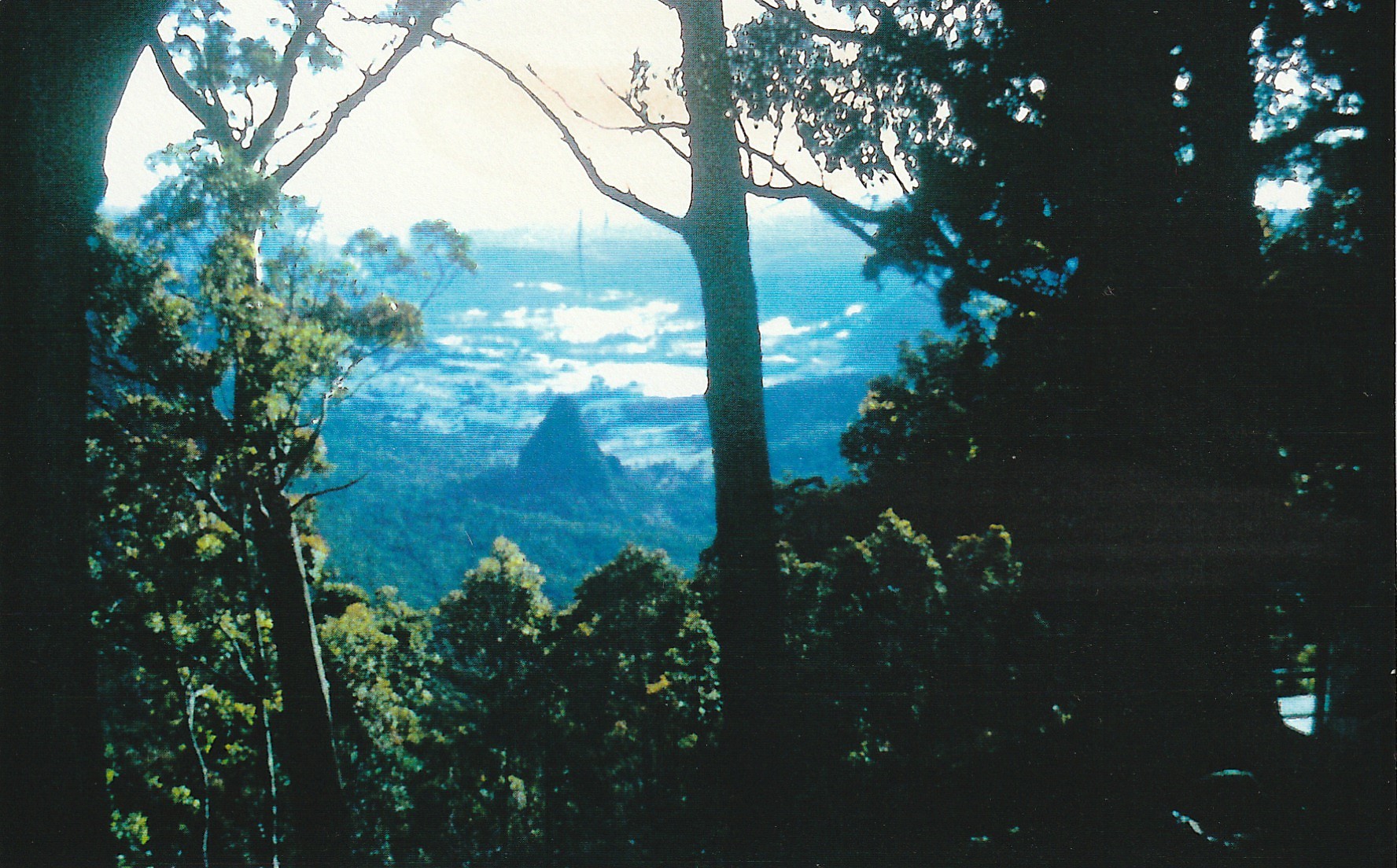
An early-morning view north from the front lawn of the Binna Burra Mountain Lodge across toward Egg Rock and beyond gives a sense of the beauty and serenity of Lamington National Park.
A hike along the Rainforest Circuit was good exercise and produced satisfying photos. I came across red necked pademelons, bush turkeys, and a number of birds. Circling about the lodge, awaiting handouts from the kitchen window were kookaburras, crows, and brightly-colored parrots.
I worked up a good appetite hiking the trails in the late-afternoon 55-degree temperatures, but dinner at the lodge was up to the challenge. It was hearty and delicious. Served at large, rectangular tables overlooking miles of picturesque countryside, it also provided an opportunity to meet and chat with some of the other guests.
Following dinner there were games in the recreation room, but I chose to yield to time zone considerations and hit the hay early. The cabins were by then downright cold. I placed a plug-in radiator next to my bed and had a sound and satisfying sleep.
Day 3
Early the next morning I awoke to a cacophony of bird calls, bright sunshine, and the smell of cool, clear, mountain air. Invigorating!
After breakfast I chose to hike the Coomera Circuit, since it offered a chance to see waterfalls and was highly recommended. To the falls and back was eight miles, a great walk.
In the afternoon after lunch, I followed the Caves Circuit, a four-mile trek. Eucalyptus trees towered along the winding path, but hoped-for koalas were nowhere to be seen. (They are there, I was told, I just didn't see them.) The caves were impressive, however, and the scenery was grand.
Returning back to Brisbane, I knew my stay had been too short; two days is insufficient time for a proper visit to Lamington National Park.
Day 4
The next day I took a river cruise to Lone Pine Koala Sanctuary, the largest koala sanctuary in the world and Brisbane's most popular attraction. It's hardly off the beaten track, but I enjoyed it thoroughly, so much so I missed lunch.
Deposited back at my hotel after 3:00 p.m., I set out to find something to eat. Down the street I came across Cafe L' Univers, an attractive sidewalk cafe within sight of an 1828 windmill, said to be the oldest surviving building in Queensland. I placed an order (ham and pea soup, spinach salad, Coke), asked for something to write on, then sat down in a wicker chair at a table next to a white wrought-iron fence with green railing.
The tables were round Formica tops supported by three-footed, black iron stanchions. Mine was #26, although there were only 17 tables on the patio. I watched as a dozen small birds nibbled on a piece of French bread that had been left for them at the base of a small tree a few feet away. Possession seemed more important than dining; constant disputes sent them into miniature battles, complete with squawking and scolding.
The waiter brought me a few sheets of computer paper to write on. I made a note that two women at Table 32 were chatting over a milk shake and coffee, then watched as four men at Tables 34 and 35 debated briefly over their check, then paid, and departed.
A big clock tower a block or so away struck four. Sounds from an outdoor concert near my hotel were barely discernible. A gentle breeze occasionally stirred the tree branches overhead and sent them into graceful motion. The temperature was probably 85 degrees.
A mother, father, and pre-schooler arrived on the scene and sat at Table 34. A new waiter appeared (just starting his shift, apparently), with white shirt, black bow tie, black vest, pony tail, and earring. He removed my empty dishes. A single "bong" from the clock signaled 4:15. The waiter returned with the dessert menu. I ordered sorbet: lemon and mango, total of three scoops.
By then the piece of bread had been pecked at until only the crust remained. The birds lost interest. The big digital readout atop a building across the street read 4:32, but I didn't recall hearing the clock tower signal half past.
The family finished its drinks and departed, but not without a fuss from the pre-schooler
Two elderly people sat down at Table #33 and ordered tea. They carefully poured hot water through a strainer into their cups. He was wearing a green shirt, pink shorts, and blue and white sneakers with chartreuse laces. She was wearing a white t-shirt with a design on the front, aqua blue and white shorts, white sneakers, and a red and white cap.
A large, black crow somewhere nearby announced itself in a loud and demanding call. I couldn't see the bird, but it sounded like a crow. I mixed up the remaining lemon and mango sorbet in my glass; it was a tasty combination.
A few birds returned to peck hopefully at the crust. Frustrated, they departed. Tiny little bugs had fallen into my dessert, presumably from tree branches or leaves overhead. I fished them out with a spoon. I had probably consumed a couple in my soup and salad without noticing.
The bill was delivered just as the clock struck 5:00. The waiter placed a salt shaker on the sheet so it wouldn't blow away. The wind had picked up a bit. It was a late-afternoon, more mellow sun that shone light on the Sheraton Brisbane Hotel across the way.
The tab was $19.30 Australian (about $14.20 US), surely a bargain even without the food! The digital readout signaled 5:11 when I finally got up from my table to return to the hotel.
Day 5
Flying on to Alice Springs the following day, I had time to check in at my hotel and take a few pictures before my "Take a Camel to Dinner" adventure.
The bus took us five miles outside Alice Springs to the Frontier Camel Farm, which included a Camel Museum and Arid Australian Reptile display.
These were interesting diversions, but I was anxious for the ride. I'd been told to expect ornery camels; smelly, obstinate, spitting beasts, that might bite, but as we approached the animals, they seemed quite placid. The "Ride at your own risk" notice in the camel farm brochure wasn't very comforting, however.
To accommodate 18 riders, 14 camels had been gathered together for our "safari." (Some guides walked.) A rope, with one end attached to the camel's nose pin and the other end to the camel in front, kept the one-hump animals cooperative. Should a nose pin pop out, there was another rope around the neck to prevent desertion during the ride, for the only one who knew anything about controlling the beasts rode at the front of the "train."
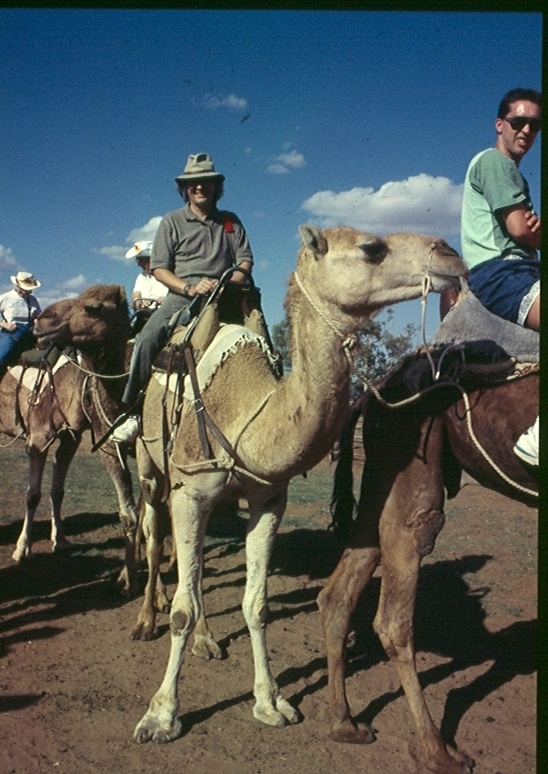
Noah (that's the camel) and I (center of photo) are ready for a ride, which, I'd say, turned out to be more comfortable than by horseback. (Photo by one of the guides.)
Although camels look awkward and clumsy, riding them is quite easy and pleasant. I was perched way up in the air and the only distraction was wondering whether or not I was going to fall off.
While this phobia was brief, interference from flies was not. The good news: we were not in the really bad fly season. The bad news: as a newcomer, how was I to tell? The flies were smaller than common US house flies, but their habits were similar.
They buzzed about my head and made frequent attempts to enter my ears, nose, mouth, and eyes, so as a result, I often found myself waving my arms about wildly. I then understood why some Australian hats have all the little corks on strings along the rim: to shoo the flies away!
Aside from the distraction of flies, the ride was great. We lumbered along the Todd River (the river bed was dry) with much chatter; everyone talking to the other riders and to the camels, too. I took pictures galore. The river red gum trees were beautiful and the late-afternoon colors vividly enhanced the scene.
Everybody had a good time, and there wasn't one report of spitting or biting. The camels behaved themselves, too. After about an hour we arrived at the Chateau Hornsby Winery, where we were treated to wine tasting and a brief cellar tour before dinner.
Dinner itself was delicious: roast of prime beef (alternatively, baked fillet of Northern Territory fish), four salads, home-made beer bread, wine, and cake for dessert. Afterward we enjoyed friendly conversation for a while before boarding the bus for distribution back to our various hotels.
It was a great adventure.
Day 6
The next morning was the start of a two-day, one-night excursion to Ayers Rock. While this is a major tourist attraction, climbing to the top of the rock is attempted by only a fraction of the visitors.
When I originally planned my trip, I thought Ayers Rock was a short ride from Alice Springs. The five-and-a-half-hour bus ride cleared up that misconception! Upon arrival at my hotel, I only had time to register and grab a quick hamburger (which included lettuce, onions, and beets!) before it was time to reboard the bus for a drive to the Olgas, a rock formation 17 miles west of Ayers Rock.
The scenery was stunning, and a photo-rich walk through Mt. Olga Gorge was a delight.
The bus then transported us to an Ayers Rock viewing area to witness the changing colors at sunset. Unfortunately, when I was there Mother Nature didn't have a very colorful palate for the evening's show. The giant monolith just looked red, but a lovely sight, nevertheless.
Day 7
Warnings by several people whom I'd met on the trip, including negative remarks by bus-driver Bill, left me apprehensive the next morning when those who wished to could attempt climbing Ayers Rock.
I was anxious to make the climb, but concerned since so many had cautioned me about the dangers. Some had advised that climbing down might be even more difficult than going up. Plaques have been placed at the base of the rock in memory of climbers who lost their lives ascending or descending.
It was cold, about 50 degrees. The wind was gusting. There were reports of 40-knot gusts at the top. From a distance the climbing path appeared to be at an angle of about 30 degrees. That seemed manageable.
Up close, however, it looked more like 60 degrees! At the base there's a moderately steep incline bordered by a jumble of boulders, the top of which is called "Chicken Rock." That's where some climbers chicken out.
With camera over one shoulder and camera bag over the other, I started up. "Don't hurry," we had been advised. How was that possible?
Just beyond Chicken Rock was a long, heavy-duty chain strung between vertical steel posts cemented in holes drilled in the rock. It was too steep to just walk up, so you had to pull yourself up the incline. Easy! For a few dozen steps.
Then I found my 57-year-old heart was pounding wildly. Fortunately, you can sit down and relax whenever you want. That gave me a chance to catch my breath and contemplate whether I'll ever get to the top alive, and if so, if I'll ever get down.
The wind made a whistling sound as it blew around me and past my open mouth, gasping for air.
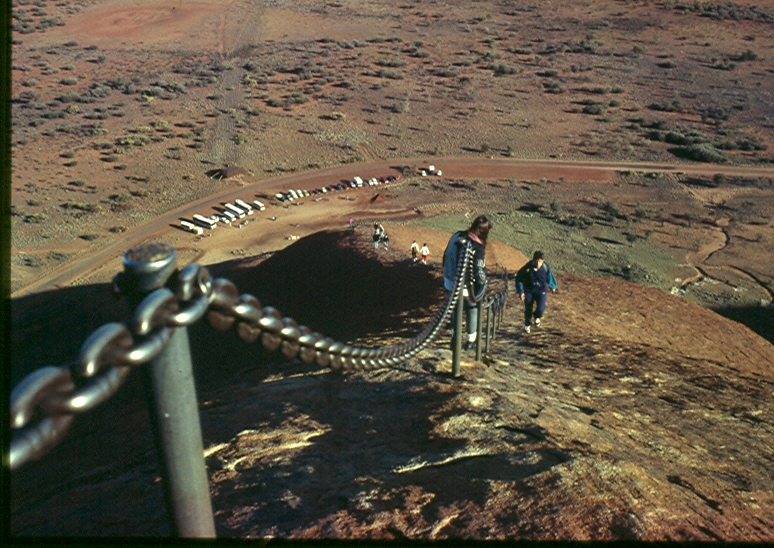
This chain is the only assistance available for those climbing Ayers Rock. Straying from the chain is not recommended, as it's sometimes rather slippery. The right side of the chain is for climbing up. The left side for climbing down. Numerous tourist busses are parked at the base of the rock.
Others seemed to be making the climb, though, without a lot of trouble. Gosh, if they could do it . . . But a lot of them were kids. You know, teenagers, or robust young adults in their twenties.
I decided to think less and climb more, and about half way up the chained section I saw someone in front of me coming down. It was an old man! With a cane! As he got closer, I got another surprise. It was actually an old woman with a cane!
That did it. I was going to climb that miserable hunk of sandstone even if it killed me!
At least one passenger from my bus didn't make it to the top. (Alright, if you must know, he had a sore foot before he started the climb.) But there were several sections of the route that gave me second thoughts about whether it was possible to reach the peak, were it not for all the climbers merrily negotiating the obstacles.
At the end of the chained section, I felt a real sense of satisfaction. I'd really accomplished something! Then someone coming down told me I was only one-third of the way up the one-mile trek.
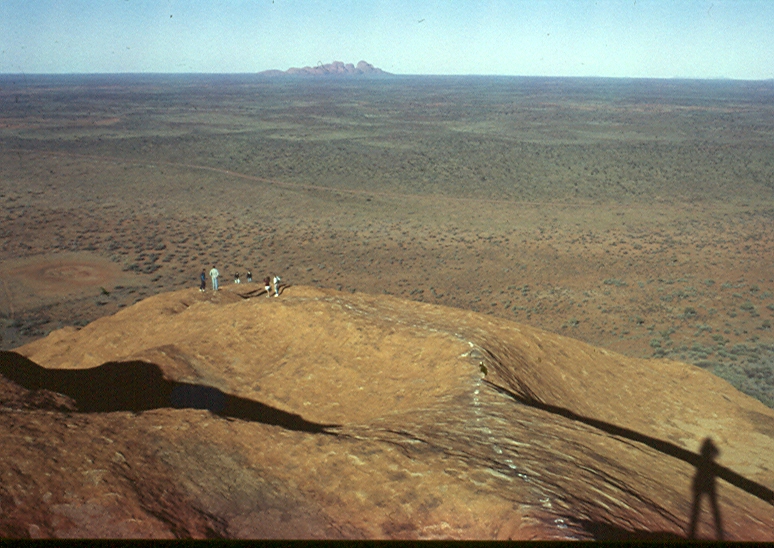
The view from the top of Ayers Rock was impressive. You can just make out the walking path in this photo: footprints painted on the rock. There are no chains or railings or safely barriers. You're on your own. I think that's the Olgas off in the distance.
To the summit and back took me over two hours, longer than average, but oh, what a sense of accomplishment! It was steep and strenuous, but, wow, what a high! (No pun intended.) I took loads of pictures.
It was thrilling, satisfying, wonderful!
The remainder of the day was consumed with sightseeing around the base of Ayers Rock (beautiful scenery, great photos), then the bus ride back to Alice Springs. The following day I departed for Darwin.
Day 8
About as far south of the Equator as Grenada is north, Darwin is closer to Indonesia and Southeast Asia than to any other large city in Australian.
In World War II it was bombed by the Japanese and became a major military base for the Allies.
Most of the city was destroyed when Cyclone Tracy hit on Christmas Day, 1974. Consequently, much of Darwin is relatively new and modern, a far cry from the rough and tumble frontier town I expected. Although excluded from many Australian tours, Darwin was one of the principle reasons I traveled to Australia.
In the late afternoon I took a walk around town, then stopped at a bench in Bougainvillea Park (also known as Bicentennial Park) to gaze off across Darwin Harbor at the soon-to-be-setting sun. It was 6 p.m. and the early-evening breeze was warm and pleasant.
As I continued along the park path back toward my motel, I noticed someone walking toward me. It was a secluded section of the park and he appeared to be watching me intently. His dark hat was wrinkled and his shirt and trousers were old and worn. I was suspicious. He continued to study me.
All sorts of thoughts raced through my mind. I wondered if he was armed. I wondered if I should just turn and run. I kept walking, though, trying to appear nonchalant. He stopped directly in front of me, blocking the path. On, no! Was he after my money or my life?
As it turned out, it was the latter.
"I'm Brother John," he said, "Tourist Chaplain." He explained that he walks about the city frequently offering his assistance to any tourist or visitor he finds. "Please call me," he said, "or write to me for any reason." He gave me a tiny brochure: "Four things God wants you to know." In it were bible passages.
Brother John's name, address, and phone number had been carefully stamped on the front and back.
"If you forget film you leave for developing," he said, "or clothes you leave at the cleaners, just let me know. I'll get them for you and send them to you. Anything at all. Please write or call."
Day 9
At 7 a.m., I was picked up and driven to Litchfield, one of the Territory's newest parks.
To get there from Darwin, we traveled in a four-wheel-drive Land Cruiser about 60 miles, half of which was on rust-colored, dirt roads.
The park has many waterfalls, waterholes, and pools, and it turned out to be a largely hike-and-swim day. Along with rainforests and sub-tropical woodlands, there are 32 falls in the park, most spring fed, so they flow all year round. We went to Wangi Falls, Sandy Creek Falls, Tolmer Falls, Florence Falls, and the Buley Rockholes, three of which allowed swimming.
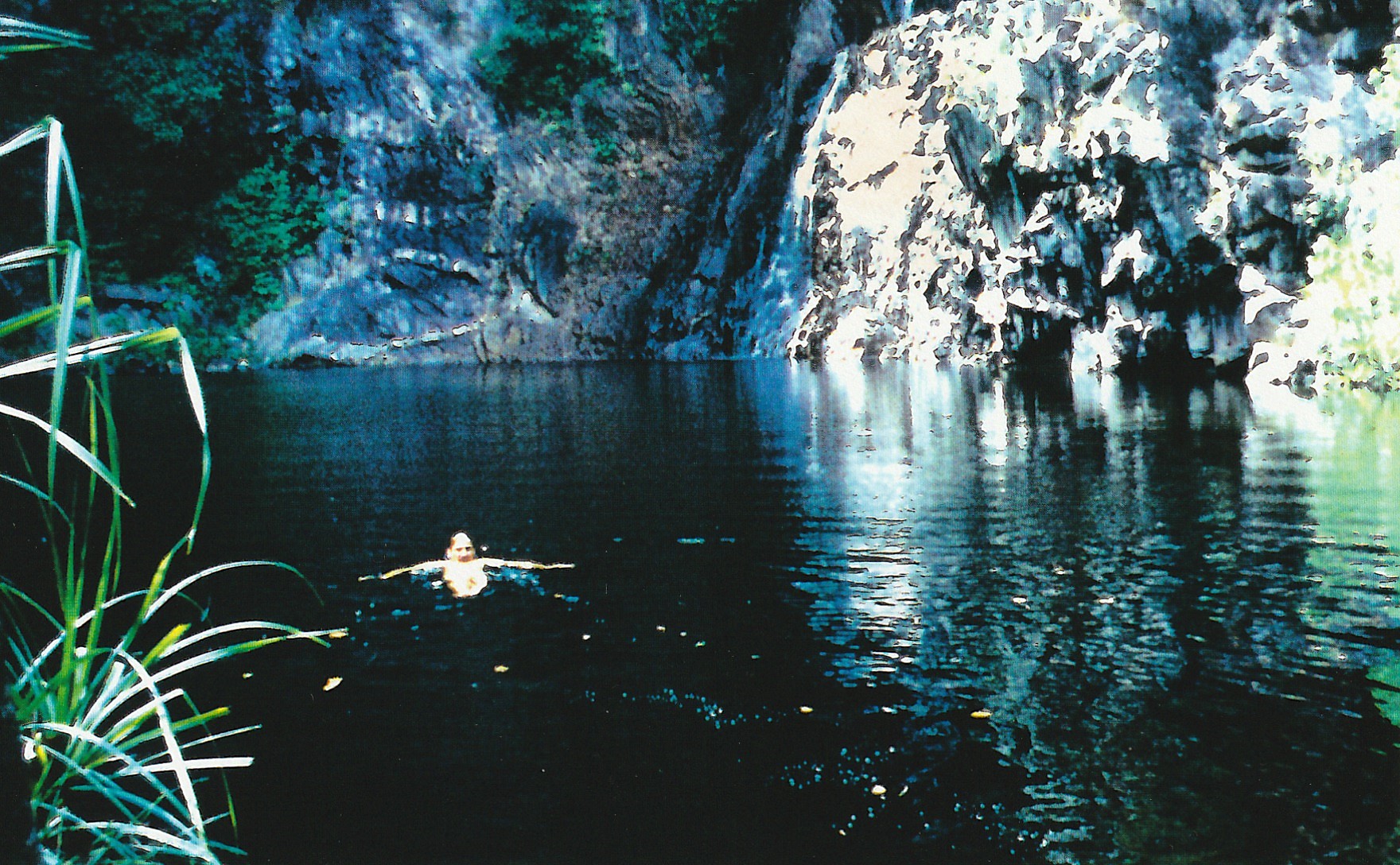
The one-mile hike to Sandy Creek Falls (in Litchfield National Park) makes a dip in the lake even more rewarding. I sighted a water monitor (lizard) along the bank on my swim back from the waterfall. The guide said they're harmless. Good thing, since this one was over two feel long! They grow to several times that length. (I'm not the one in the water.)
I swam at two. Very refreshing and invigorating.
Along the way we saw a walleroo, wallaby, water monitor, heard some wild pigs, saw a crocodile, frilled neck lizard, and many huge termite mounds.
The meridian termites, which used to be called magnetic termites, build nests that are high but narrow, all aligned in a north-south direction. From a distance the mounds look like rows of tombstones in a cemetery. After up-close examination and photos, our driver/guide, Chris, announced that we'd have lunch at Blyth Homestead. How posh, I thought.
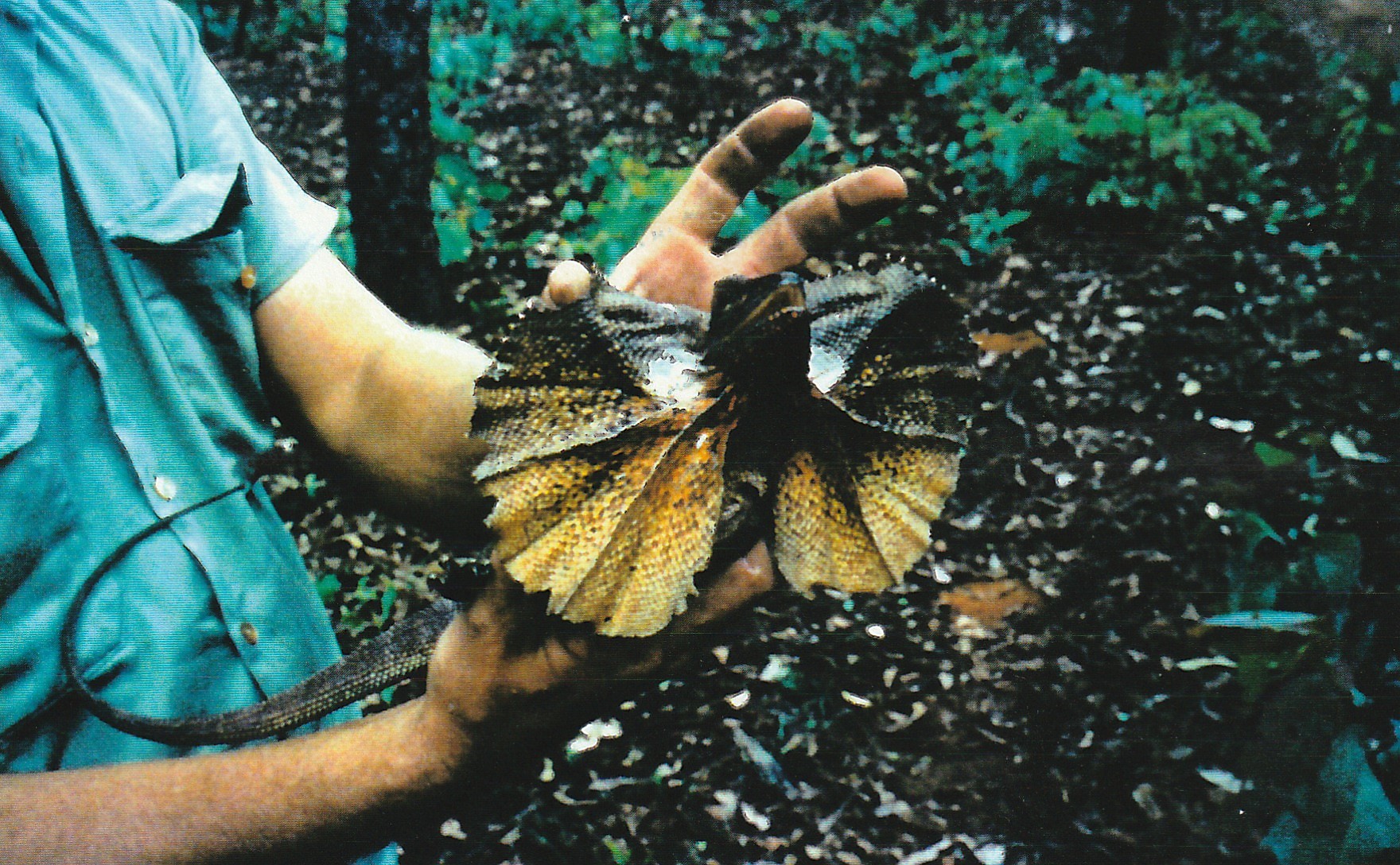
Our Litchfield Park driver/guide, Chris, captured this frilled neck lizard for us to examine. Chris had a 30-yard chase to catch it and received several scratches from the lizard's sharp claws. After we got a good, close-up view, it was released.
When we reached the homestead, we found an old, tumbled-down, one-room shack. Did I say tumbled-down? It had actually fallen apart!
Chris retrieved a folding table from atop the land cruiser. He unpacked tiny folding chairs and produced a cooler containing complete picnic lunches for everyone.
Our picnic was some 30 yards from Blyth Homestead. The flies quickly found us and joined in the picnic, so there were lots of us to enjoy the meal.
A wild afternoon ride over huge rocks, up and down steep grades, and through deep water puddles (four-wheel drive absolutely mandatory) took us to Lost City, where we found fascinating rock formations.
If you studied them for a few minutes you could see all sorts of figures: a man standing up, a dog sitting down, a clenched fist. It was a three-dimensional Rorschach test! I took a zillion pictures. Kodak should advertise that place.
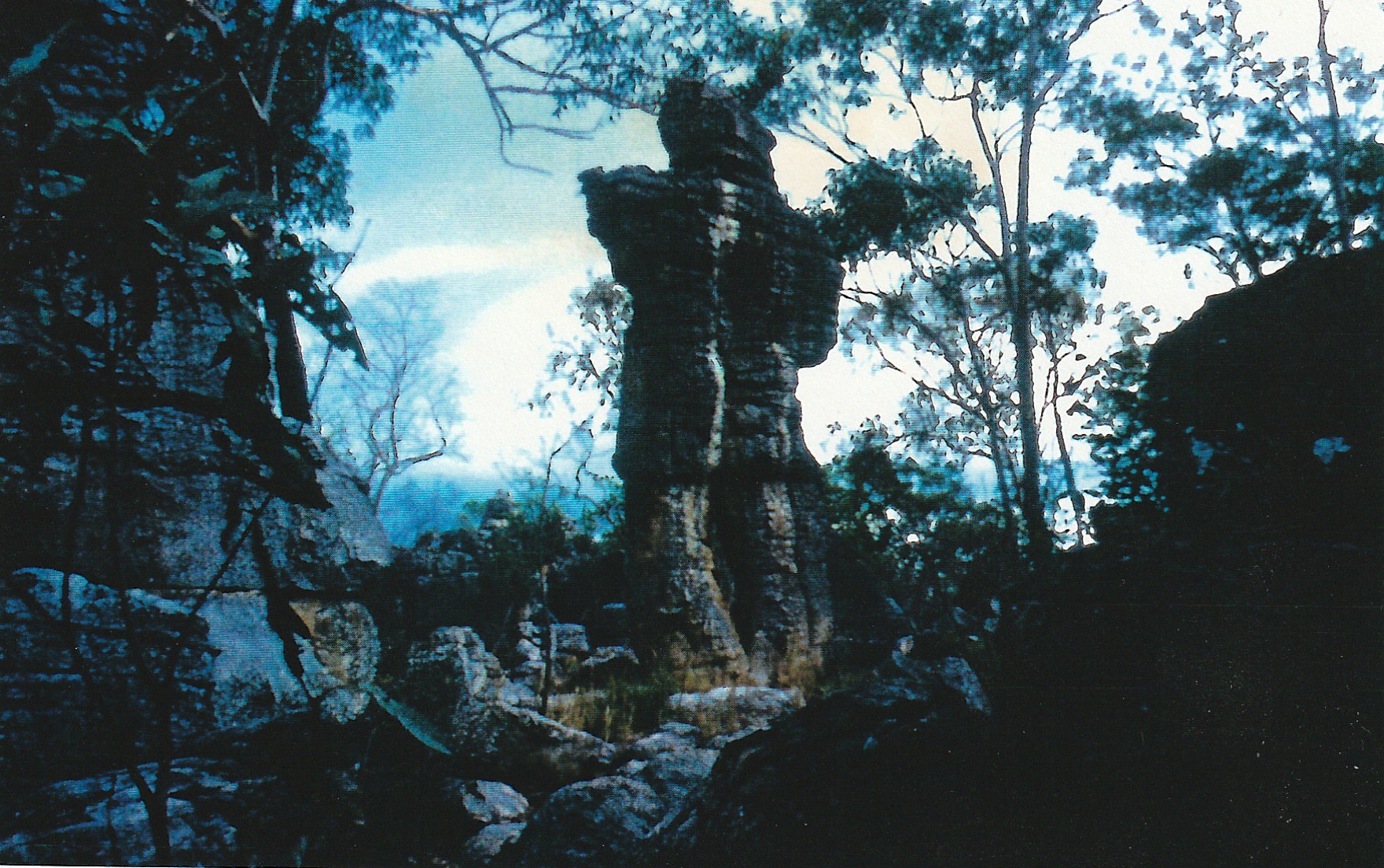
One of the many intriguing rock formations at Lost City.
Day 10, 11, 12, and 13
During my stay in Darwin I also visited Bathurst and Melville Islands, took a two-day, one-night bus trip to Kakadu National Park, and went on a one-day Territory Wildlife tour. All were interesting trips.
I then flew on to Cairns.
Day 14
To many, the most impressive feature of Australia is the Great Barrier Reef. With 1200 miles of living coral and 30,000 species of marine life, it's the richest marine resource in the world.
Cairns, situated roughly at the center of this natural attraction, is a bustling tourist town, with a liberal helping of hotels, motels, restaurants, and shops.
I boarded Reef Adventure III, a catamaran bound for Fitzroy Island and a full day of water sports and excitement. The captain described the seas as "moderate chop," but I noticed that boat motion had raised significant passenger interest in the little white paper bags the crew had made available.
We arrived at the island only after a few children had chosen to make use of them. (Had the voyage been much longer, I would have been a participant as well.)
A loud-speaker announcement suggested that passengers who had tickets to continue to Green Island might wish to spend the day at Fitzroy instead.
There's a multitude of activities at the island to delight any interest: hiking, swimming, sunning, snorkeling, diving, canoeing, sailing, glass-bottom boating, and more.
In the morning I hiked to Nudey Beach (no, I saw no nudes), had a ride in a glass-bottom boat, then ate a good lunch. Afterwards, however, I found I was just too pooped to participate in any other activities, so I found one of the comfortable chairs around the pool, sat down, and enjoyed doing absolutely nothing.
The temperature was perfect, there was a gentle breeze, and no flies! I was quite content to while away the entire afternoon watching others sun, swim, snorkel, and scuba.
In the late afternoon the boat returned us to Cairns on much calmer waters and I was back at the hotel at 6:30.
Day 15
The next day, my last full day in Australia, was a trip to Kuranda. The 47-mile train ride, over mountainous terrain, was just the beginning. Strolling through a fascinating market, watching a performance at the Tjapukai Dance Theatre, taking an army duck ride through a rainforest and into a lake, trying out the boomerang, and visiting the Butterfly Sanctuary were all great fun. Kuranda is a tourist favorite.
Returning to Cairns by bus, I decided not to go directly back to the hotel, since my time Down Under was quickly running out. I didn't want this experience to conclude. I wanted to somehow prolong the trip, extend the exposure to the country's unique attractions.
The sights had been thrilling, the experiences so rewarding. I got off the bus at The Pier, a large, modern shopping mall at the edge of the harbor, and wandered about aimlessly. I took a few pictures of the city in the waning light of sunset, then strolled slowly along Esplanade Street and through some of its shops and stalls before finally reaching my hotel. I was saddened to be at the conclusion of such a happy time.
Day 16
Up at 6:00 the next morning, I was at the airport shortly after 8:00. As expected, it was a long trip home, with plane changes in Honolulu and Los Angeles, but that was okay.
The aura of my Australian adventures remained. I had a long, leisurely opportunity to recall and enjoy the experiences, thrills, and delights of my wonderful destinations Down Under!
|







